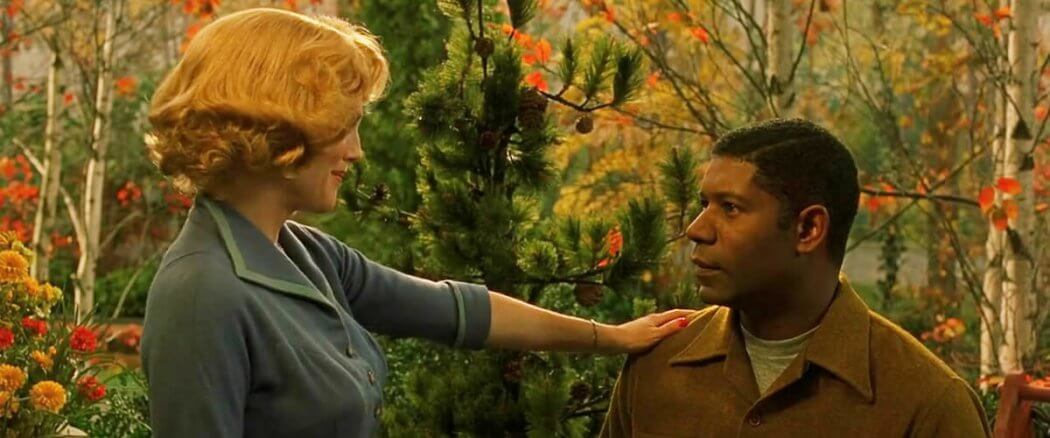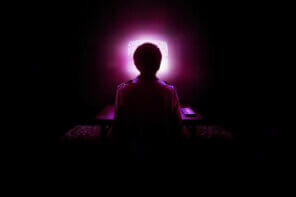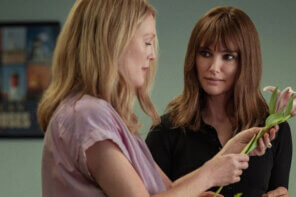For me, the most wonderful time of year is not the end of November to the end of December, but the end of September to the end of October. The feverish flush of trees, the swells of wind, sunsets that smear across the sky; it is a parade, all the more gorgeous because it is passing by. And it always reminds me of Far From Heaven, a film that lives in the fall.
Cathy Whitaker (Julianne Moore) is, according to the Hartford Weekly Gazette, the woman behind a great man, Frank Whitaker (Dennis Quaid). Together they are “Mr. and Mrs. Magnatech,” players of the company way, perfect parents and spouses, figureheads of the good American life circa 1958. This is a film of surfaces, where everything is what it seems; like gas spilled in water, it is striped with the prettiest color and the deadliest toxins.
Reconstructed Memory
From the start, we recognize Far From Heaven as a reconstructed memory of ‘50s melodrama – specifically, the films of Douglas Sirk, whose stylistic sheen coated a subtle burlesque, questioning the status quo. In Sirk’s reflective veneer, several decades of intellectuals have glimpsed their own worldview, but it has always been a bit scuffed by a production code that prevented direct engagement of social issues and Sirk’s own Brechtian devices; as a result, true catharsis is obstructed, intentionally so. Far From Heaven fills an unrealized need: a millennial re-vision of a mid-century melodrama, in which the unspoken can finally be spoken, but the pain is still the same – and this time, we are feeling it.
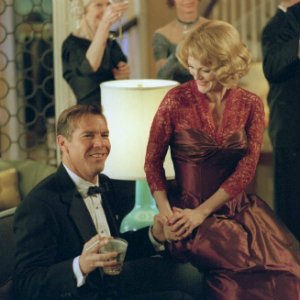 Of course, some retrofitting is necessary, beginning with the story. Frank is not being frank with himself or his family about a “sickness” – what another character calls “that word” – which would never be uttered in the era and yet is written into a line of this film: homosexuality. Even more fantachronistic, Cathy discovers Frank, in blue on blue light, embracing another man.
Of course, some retrofitting is necessary, beginning with the story. Frank is not being frank with himself or his family about a “sickness” – what another character calls “that word” – which would never be uttered in the era and yet is written into a line of this film: homosexuality. Even more fantachronistic, Cathy discovers Frank, in blue on blue light, embracing another man.
To curb the anonymous encounters and “cure” himself, Frank begins therapy, just as an “incredibly handsome, charming, highly over-qualified”* black gardener named Raymond Deagan (Dennis Haysbert) begins working for the Whitakers and befriends Cathy. And in this Far From Heaven world, the difference between friend and enemy is one transgression.
Bigger Than Life
Director Todd Haynes reveres Sirk’s films as vessels of “spookily accurate” emotional truths, a belief that might be posited for any excellent melodrama, since the genre is bigger than life – in the sense that it has a bigger view of life, encompassing events and emotions that are frequently happening but seldom witnessed en masse – except in the movies, which are big enough to include everybody. However you still need life-tamers who can handle the mangy beast of melodrama without being devoured by it.
Far From Heaven “is a love story, but like all affecting love stories, the love itself is almost too big for the characters to manage,” Haynes expounds in the director’s commentary, “so it spills into Elmer Bernstein’s score, Ed Lachman’s cinematography, Mark Friedberg’s design, Sandy Powell’s costumes. And these kinds of films leave room for those stylistic elements to have a voice.” Those voices form a choir, in front of which Quaid, Haysbert and Moore stand and deliver solos like you’ve never heard before – especially Moore, who in this script acts as the pulley our cord of emotions thread through. Somehow she breaks into a character trapped in her own body, house, marriage and life.
Certainly, life is not simple for Cathy, who repeats the word “certainly” in every fourth or fifth line, like a liturgical stimulus and response to herself in service to a god of order. In a white neighborhood, as a black gardener, Raymond is quite literally an outsider; because of that, he is the only one Cathy feels she can talk to. So they talk. And so does the town.
Shape and Color
The talk turns fortissimo when Cathy and Raymond accidentally meet at an art exhibit and admire a painting by Joan Miró. “I don’t know why, but I just adore it, the feeling it gives. I know that sounds terribly vague,” Cathy apologizes. “No, no,” Raymond encourages her, “actually, it confirms something I’ve always wondered about modern art, abstract art…that perhaps it’s just picking up where religious art left off, somehow trying to show you divinity. The modern artist just pares it down to the basic elements of shape and color.”
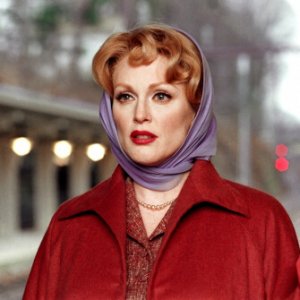 Could this be the same divinity Hamlet considers, “that shapes our ends, rough-hew them how we will”? If such divinity is present in the elements of shape and color, then it is omnipresent in Far From Heaven. A cornucopia of color overflows the frame of each shot, just as every character or prop is designed and destined for its placement, a quality articulated in G.K. Chesterton’s Manalive:
Could this be the same divinity Hamlet considers, “that shapes our ends, rough-hew them how we will”? If such divinity is present in the elements of shape and color, then it is omnipresent in Far From Heaven. A cornucopia of color overflows the frame of each shot, just as every character or prop is designed and destined for its placement, a quality articulated in G.K. Chesterton’s Manalive:
The sensation of a certain cut and coloured clearness that belongs rather to the things of art than to the things of experience. The broken flowerpot with its red-hot geraniums, the green bulk of Smith and the black bulk of Warner…all these seemed unnaturally distinct and definite. They existed, like symbols, in an ecstasy of separation. Indeed, every object grew more and more particular and precious because the whole picture was breaking up. Things look so bright before they burst.
The Fall of Grace
Indeed, the brightness of the film’s cinematography bursts forth, in form and palette, its strength made perfect by the people filling it. We can see heaven is already here, in a deeply periwinkle moonlight, a glance of understanding, a lilac scarf blowing away in the wind. But we can feel heaven is not yet, in a marriage disintegrating, a gaggle of gossips, a child assaulted.
That lilac scarf is Cathy’s, found in a tree by Raymond. She wears it again in one of the most exquisitely excruciating scenes of the film. “Do you think we ever really…see beyond…the surface of things?” She asks. “Just beyond the fall of grace / behold that ever shining place,” Raymond replies. “Yes, I do. I don’t really have a choice.”
As the leaves fall and hope leaves, Raymond, Cathy and Frank don’t really have much choice, accepting “the limitations imposed on women, or gay people, or people of color, [that] might be shared, or shareable,” Haynes suggests, “but not necessarily equal…there are contradictions and hierarchies even in the ways we are oppressed.” The film wants to set them free, but doesn’t have the power, so it grieves.
And yet this grief is power, and it’s why we so desperately need Haynes’ incarnation of Sirk’s melodrama, particularly at The End – one that is not “happy-but-actually-ironic,” or “happy-but-only-because-of-the-studio-system” – it is nothing but the truth, the natural consequences of a transgression which is both moral and social, real and perceived: Raymond, Cathy and Frank isolate, to master their Art of Losing.**
But something is lost and something is gained, and as clouds gather in the closing shot, the camera rises and rises, finally resting its gaze on the branch of an autumn cherry tree, pure and flowering.
______________________________________
*Todd Haynes, in the director’s commentary.
**The title of a poem by Elizabeth Bishop you should read now.

